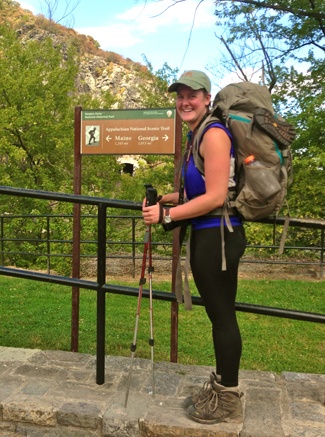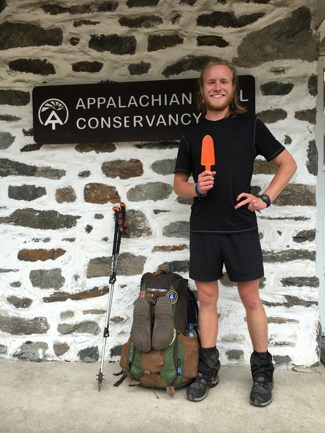by Jordan Bowman
2016 Sees Rise in Ethical Hiking Practices Among Appalachian Trail Hikers
August 11, 2016
On virtually every day of the week, the Appalachian Trail Conservancy (ATC) Headquarters and Visitor Center in Harpers Ferry, West Virginia is bustling with activity.
Thru-hikers, section hikers, flip-floppers, day hikers or simply people fascinated by the Appalachian Trail (A.T.) — ATC Headquarters receives all sorts of visitors hoping to learn more about hiking techniques, local footpaths and, of course, the history of the Trail itself.
“We receive a kaleidoscope of people in the visitor center,” said Laurie Potteiger, information services manager for the ATC. “And with the increasing popularity of the Trail and outdoor recreation in general, the crowd gets bigger every year.”

She isn’t exaggerating. Though the peak number of thru-hikers passing by the center has likely come and gone — a record 742 thru-hikers stopped by the center during June, traditionally the Visitor Center’s busiest month — the ATC will continue to draw large crowds of visitors throughout the year. So far, the number of visitors has increased by 27% from 2015: 19,089 individuals have stopped by the visitor center already this year. We are pleased to see the growing interest in hiking on the A.T., linking more individuals to the benefits of being outside and reconnecting with nature.
Overall Trail-usage has increased steadily over the past several decades for a variety of reasons — including exposure from books and films like A Walk in the Woods and Wild and continued popularity of outdoor recreation — consequently placing more strain on fragile A.T. resources. Thus, it has become increasingly vital to assess ways to maximize our conservation programs as well as our outreach and educational efforts. Using data gathered throughout the year helps us monitor the effectiveness of our efforts and adjust them as trends become clear.
After comparing the numbers collected at ATC headquarters from January to July 2016 to the same time last year, here are some of our key discoveries:

![]() The number of 2016 flip-flop thru-hikers has increased 22%
The number of 2016 flip-flop thru-hikers has increased 22%
One of the primary concerns in recent years has been overcrowding on certain sections of the A.T., particularly when the mass of northbound thru-hikers (commonly known as “the bubble”) begins in March and April. To help address this, the ATC has promoted alternate thru-hiking methods — a.k.a., flip-flopping — that help alleviate the strain on the trail and thin crowds for a more isolated hiking experience. The increase in flip-flop thru-hikes indicates that many hikers have recognized the benefits of non-traditional thru-hiking itineraries, both for themselves and the Trail.
![]() The number of 2016 section hikers has increased 26%
The number of 2016 section hikers has increased 26%
The ATC continues to highlight the the entire A.T., such as the ability to choose less-populated sections of the Trail, hike in more favorable weather conditions and take less time away from family and work. This trend continues to grow, indicating that many A.T. hikers have taken this message to heart.
![]() Over 3,100 hikers have used the ATC Voluntary Thru-Hiker Registration so far this year, a 62% increase over all 2015 thru-hike registrations
Over 3,100 hikers have used the ATC Voluntary Thru-Hiker Registration so far this year, a 62% increase over all 2015 thru-hike registrations
2016 marked our second year using the voluntary thru-hiker registration system, which is designed to help aspiring thru-hikers choose less-crowded starting dates and provide the ATC with valuable Trail usage estimates. We are excited to see the amount of interest in this system, as it shows that hikers are similarly concerned with preserving the Trail and the A.T. hiking experience. Over 2,500 thru-hikers have also requested trail updates from the ATC using this system, allowing us to email them Trail condition updates, hiking tips and other useful information. In 2017, the voluntary registration system will be upgraded to allow section hikers to plan their overnight trips, helping all A.T. campers avoid crowding. We plan to release more information about this upgrade soon.
We have also taken note of other less-quantifiable trends in 2016 regarding Leave No Trace Principles and preserving the hiking experience:
![]() We have witnessed growth in the Trail Karma movement, where hikers and A.T. enthusiasts are celebrated for contributing in some way to the betterment of the Trail community — from picking up litter to helping other hikers minimize their impact on the environment. Trail Karma is directly tied to our “Protecting the Appalachian Trail Hiking Experience” (PATHE) initiative, which aims to effectively manage the effects of high impact use of the A.T.
We have witnessed growth in the Trail Karma movement, where hikers and A.T. enthusiasts are celebrated for contributing in some way to the betterment of the Trail community — from picking up litter to helping other hikers minimize their impact on the environment. Trail Karma is directly tied to our “Protecting the Appalachian Trail Hiking Experience” (PATHE) initiative, which aims to effectively manage the effects of high impact use of the A.T.
![]() We have seen a shift in attitudes toward some conservation-centric practices that were sometimes ignored or derided in the past, such as carrying a trowel for waste disposal.
We have seen a shift in attitudes toward some conservation-centric practices that were sometimes ignored or derided in the past, such as carrying a trowel for waste disposal.
 The ATC has implemented multiple means of outreach to the hiking community to help educate hikers about minimizing their environmental impact and the importance of ethical hiking practices. Some of these methods include increased educational signage at trailheads and shelters, direct hiker interactions at hiking events such as the Flip-Flop Festival and Trail Days, various forms of social media outreach and, on June 20, expanding the A.T. Visitor Center in Monson, Maine to inform hikers about the special regulations present in Baxter State Park. More than 850 visitors have stopped in at the Monson Visitor Center since its opening, and the majority of the northbound “bubble” has yet to reach the Maine border.
The ATC has implemented multiple means of outreach to the hiking community to help educate hikers about minimizing their environmental impact and the importance of ethical hiking practices. Some of these methods include increased educational signage at trailheads and shelters, direct hiker interactions at hiking events such as the Flip-Flop Festival and Trail Days, various forms of social media outreach and, on June 20, expanding the A.T. Visitor Center in Monson, Maine to inform hikers about the special regulations present in Baxter State Park. More than 850 visitors have stopped in at the Monson Visitor Center since its opening, and the majority of the northbound “bubble” has yet to reach the Maine border.
Considering all of these factors, we are thrilled to see that our efforts to broaden the knowledge base of A.T. hikers appear to be working.
“Preserving the hiking experience is a top priority among the vast majority of Appalachian Trail visitors,” Potteiger said. “It’s truly uplifting to see and hear about hikers embracing these practices and being willing to change the ways in which they may have hiked or camped in the past.”
Beyond engaging the hiking community directly, the ATC has taken many other steps to enhance its stewardship of the Trail. For instance, the ATC has hired 30 seasonal staff members for the 2016 hiking season, including caretakers/ridgerunners, corridor stewardship technicians and other conservation-centered positions. These individuals are the frontline for the ATC, hiking and camping along high-use sections of the A.T. to oversee trail conditions and provide hiking tips and Leave No Trace information to visitors.
These positions do not include the additional personnel that are brought on by separate A.T. trail maintaining clubs and other conservation groups/agencies in response to the Trail’s popularity. For example, the Georgia Appalachian Trail Club and Nantahala Hiking Club of North Carolina began a 2016 Trail Ambassador program for volunteer caretakers/ridgerunners. Through this program, three additional ridgerunners were hired, along with a USFS Forest Protection Officer. In the Great Smoky Mountains National Park, the park’s backcountry ranger began his season to coincide with the thru-hiker “bubble.” The ATC also remains committed to ongoing communication and coordination with the 31 Trail maintaining clubs, helping them to maintain and improve the structure of the Trail and inform surrounding communities about effective stewardship of the great outdoors.
With all that being said, there is one final statistic that deserves to be highlighted:
![]() The number of ATC memberships has increased by 1,300 individuals over this time last year, totaling almost 45,000 members
The number of ATC memberships has increased by 1,300 individuals over this time last year, totaling almost 45,000 members
As we continue our outreach to the hiking community, we are pleased that more and more A.T. enthusiasts recognize the need for proactive preservation of the Trail and choose to be a part of our mission.
We hope to see their numbers increase substantially, as a growing and active membership provides the elements necessary for successfully implementing and expanding all of our programs — including major projects such as PATHE and the A.T. Large Landscapes Initiative.
As we look back at our successes so far this year, it underscores the reality that we still have a lot of work ahead of us. Our efforts can only succeed through the support of our members and the A.T. hiking community. By joining together, we hope to influence constant growth in responsible hiking practices and dedication in preserving the Trail for centuries to come.
![]() To find out more about the ATC’s conservation and education efforts, click here.
To find out more about the ATC’s conservation and education efforts, click here.
![]() To become a member or donate to the future protection of the Appalachian Trail, click here.
To become a member or donate to the future protection of the Appalachian Trail, click here.





